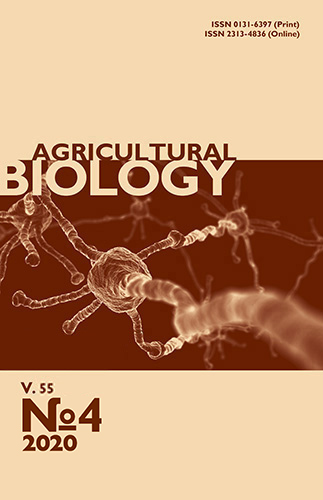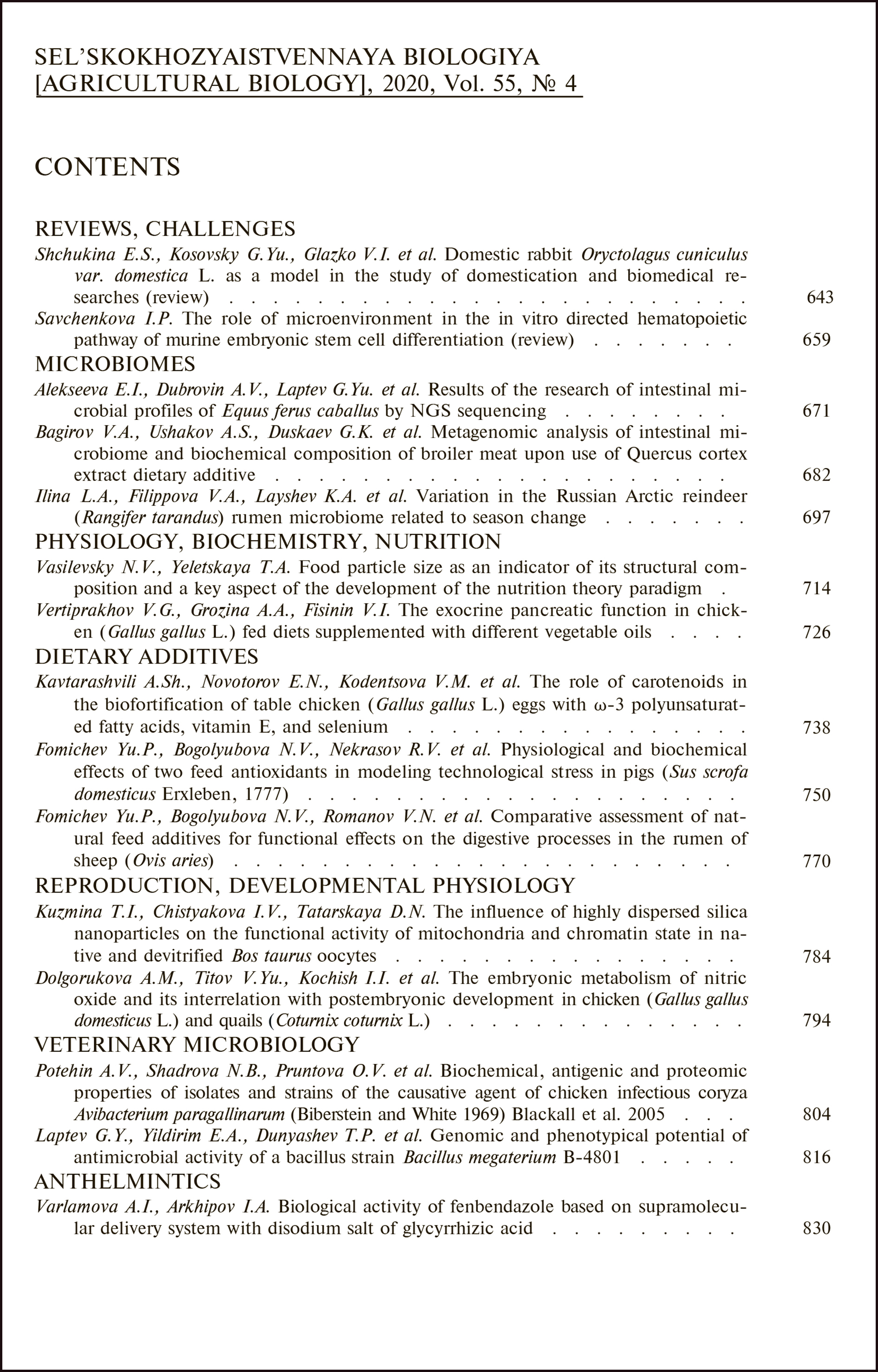doi: 10.15389/agrobiology.2020.4.794eng
UDC: 636.5:591.3:577.1
Acknowledgements:
Supported financially by Russian Foundation for Basic Research, project No. 20-016-00204-а
THE EMBRYONIC METABOLISM OF NITRIC OXIDE AND ITS INTERRELATION WITH POSTEMBRYONIC DEVELOPMENT IN CHICKEN (Gallus gallus domesticus L.) AND QUAILS (Coturnix coturnix L.)
A.M. Dolgorukova1, V.Yu. Titov1, 2, I.I. Kochish2, V.I. Fisinin1,
I.N. Nikonov2, O.V. Kosenko1, O.V. Myasnikova2
1Federal Scientific Center All-Russian Research and Technological Poultry Institute RAS, 10, ul. Ptitsegradskaya, Sergiev Posad, Moscow Province, 141311 Russia, e-mail anna.dolg@mail.ru, vtitov43@yandex.ru (✉ сorresponding author), olga@vnitip.ru, oleg_kosenko@list.ru;
2Skryabin Moscow State Academy of Veterinary Medicine and Biotechnology, 23, ul. Akademika K.I. Skryabina, Moscow, 109472 Russia, e-mail prorector@mgavm.ru, ilnikonov@yandex.ru, omyasnikova71@gmail.com
ORCID:
Dolgorukova A.M. orcid.org/0000-0002-9958-8777
Nikonov I.N. orcid.org/0000-0001-9495-0178
Titov V.Yu. orcid.org/0000-0002-2639-7435
Kosenko O.V. orcid.org/0000-0002-9516-5769
Kochish I.I. orcid.org/0000-0001-8892-9858
Myasnikova O.V. orcid.org/0000-0002-9869-0876
Fisinin V.I. orcid.org/0000-0003-0081-6336
Chistyakova I.V. orcid.org/0000-0001-7229-5766
Received May 10, 2020
The embryonic development is accompanied by the intense synthesis of nitric oxide (NO). Many processes of the embryogenesis (e.g. tissue differentiation, apoptosis) were found to be NO-dependent. However, due to the difficulties related to the control of NO metabolites in living tissues the physiological effects of NO have been studied by the indirect methods exclusively, via the effects of the inhibitors of NO synthesis or the effects of NO donor compounds and arginine as the precursor in the NO biosynthesis. But this does not allow us to establish the mechanism of the relationship between the observed effect and the metabolism of nitric oxide. Myogenesis is also considered NO-dependent since arginine, NO-synthase inhibitors, and NO donors were reported to affect the development of muscles. However, these effects are quite contradictory. The lack of data on the relationship between nitric oxide metabolism and these effects does not allow us to suggest in detail the role of NO in myogenesis and the mechanism of its influence on muscle development. And the lack of understanding of this mechanism does not allow the use of nitric oxide to correct the animal development. In this study we are presenting a pioneer view on the interrelationships of embryonic NO metabolism with the features of the postembryonic body development in different poultry species determined with the use of highly sensitive and highly specific enzymatic sensor for determination of the NO metabolites. The study was aimed at the determination of interrelationships between the intensities of embryonic NO synthesis and its oxidation and embryonic and postembryonic body growth in poultry and at the evaluation of possible application of these interrelationships for the enhancement of meat productivity. The experiments were performed in 2017-2019 on different breeds of chickens and quails. It was found that the intensity of embryonic NO synthesis is similar within any given poultry species. In most cases no significant differences between the breeds (p > 0,05). This was determined by the total concentration of all NO metabolites in the embryo. However, the intensity of embryonic NO oxidation to nitrate can vary drastically. Differences between embryos of egg and meat breeds, lines and crosses on this indicator reach several orders of magnitude. In the embryos of egg breeds, there is mainly an accumulation of nitric oxide in the so-called donor compounds. By the end of embryogenesis, their concentration reaches several hundred of micromoles. In meat breed embryos NO is mainly oxidized to nitrate. The variance of the intensity of embryonic NO oxidation within a given breed does not exceed 10-15 %. This oxidation was found to occur predominantly in the embryonic muscle tissues. The intensity of NO oxidation is similar for endogenous (synthesized by embryos) and exogenous (injected in ovo) NO donors. The injections of inhibitors of NO synthesis decreased the embryonic concentration of total NO metabolites while the NO donors to nitrate ratio was not affected. These effects suggest that the intensity of NO oxidation to nitrate is directly correlated with certain features of embryonic tissues. Therefore, it can be considered as a biochemical marker of these features. It correlates with meat productivity and is an indicator inherent to a given to a given to a given breed. It is not sex-linked and does not depend on the layer age, nutrition, etc. Thus, it can be regarded as a highly sensitive and highly specific genetically preconditioned marker. The 2-fold increase or decrease of embryonic concentration of oxidized NO (by the intraembryonic injections of NO donors or inhibitors of NO synthesis, respectively) did not significantly affect the postnatal body growth rate. The exact mechanism of the embryonic NO oxidation and the interrelationships of the latter with the development of muscular tissues are still to be elucidated.
Keywords: poultry, nitric oxide, NO donors, nitrate, embryogenesis, post-embryonic growth.
REFERENCES
- Tiwari M., Prasad S., Pandey A., Premkumar K., Tripathi A., Gupta A., Chetan D., Yadav P., Shrivastav T., Chaube S. Nitric oxide signaling during meiotic cell cycle regulation in mammalian oocytes. Frontiers in Bioscience (Scholar Edition), 2017, 9: 307-18 CrossRef
- Khan H., Kusakabe K., Wakitani S., Hiyama M., Takeshita A., Kiso Y. Expression and localization of NO synthase isoenzymes (iNOS and eNOS) in development of the rabbit placenta. J. Reprod. Dev., 2012, 58(2): 231-236 CrossRef
- Von Mandach U., Lauth D., Huch R. Maternal and fetal nitric oxide production in normal and abnormal pregnancy. Journal of Maternal-Fetal and Neonatal Medicine, 2003, 13(1): 22-27 CrossRef
- Blum J., Morel C., Hammon H., Bruckmaier R., Jaggy A., Zurbriggen A., Jungi T. High constitutional nitrate status in young cattle. Comparative Biochemistry and Physiology A-Molecular & Integrative Physiology, 2001, 130(2): 271-282 CrossRef
- Battaglia C., Ciottii P., Notarangelo L., Fratto R., Facchinetti F., De Aloysio D. Embryonic production of nitric oxide and its role in implantation: a pilot study. Journal of Assisted Reproduction and Genetics, 2003, 20(11): 449-454 CrossRef
- Kim Y., Chung H., Simmons R., Billiar T. Cellular non-heme iron content is a determinant of nitric oxide-mediated apoptosis, necrosis, and caspase inhibition. J. Biol. Chem., 2000, 275(15): 10954-10961 CrossRef
- Li J., Billiar T., Talanian R., Kim Y. Nitric oxide reversibly inhibits seven members of the caspase family via S-nitrosylation. Biochemical and Biophysical Research Communications, 1997, 240(2): 419-424 CrossRef
- Malyshev I., Zenina T., Golubeva L., Saltykova V., Manukhina E., Mikoyan V., Kubrina L., Vanin A. NO-dependent mechanism of adaptation to hypoxia. Nitric Oxide, 1999, 3(2): 105-113 CrossRef
- Cazzato D., Assi E., Moscheni C., Brunelli S., De Palma C., Cervia D., Perrotta C., Clementi E. Nitric oxide drives embryonic myogenesis in chicken through the upregulation of myogenic differentiation factors. Experimental Cell Research, 2014, 320 (2): 269-280 CrossRef
- Stamler J., Meissner G. Physiology of nitric oxide in skeletal muscle. Physiol Rev., 2001, 81(1): 209-237 CrossRef Ulibarri J., Mozdziak P., Schultz E., Cook C., Best T. Nitric oxide donors, sodium nitroprusside and S-nitroso-N-acetylpencillamine, stimulate myoblast proliferation in vitro. In Vitro Cell Dev. Biol. Anim., 1999, 35(4): 215-218 CrossRef
- Long J., Lira V., Soltow Q., Betters J., Sellman J., Criswell D. Arginine supplementation induces myoblast fusion via augmentation of nitric oxide production. J. Muscle Res. Cell Motil., 2006, 27(8): 577-584 CrossRef
- Anderson J.E. A role for nitric oxide in muscle repair: nitric oxide–mediated activation of muscle satellite cells. Molecular Biology of the Cell, 2000, 11(5): 1859-1874 CrossRef
- Lee H., Baek M., Moon K., Song W., Chung Ch., Ha D., Kang M-S. Nitric Oxide as a messenger molecule for myoblast fusion. J. Biol. Chem., 1994,269(20): 14371-4.
- Ribeiro M., Ogando D., Farina M., Franchi A. Epidermal growth factor modulation of prostaglandins and nitrite biosynthesis in rat fetal membranes. Prostaglandins Leukotrienes and Essential Fatty Acids, 2004,70(1): 33-40 CrossRef
- Samengo G., Avik A., Fedor B., Whittaker D., Myung K., Wehling-Henricks M., Tidball J. Age-related loss of nitric oxide synthase in skeletal muscle causes reductions in calpain S-nitrosylation that increase myofibril degradation and sarcopenia. Aging Cell, 2012, 11(6): 1036-1045 CrossRef
- Li Y., Wang Y., Willems E., Willemsen H., Franssens L., Buyse J., Decuypere E., Everaert N. In ovo L-arginine supplementation stimulates myoblast differentiation but negatively affects muscle development of broiler chicken after hatching. Journal of Animal Physiology and Animal Nutrition, 2016, 100(1): 167-177 CrossRef
- Tirone M., Conti V., Manenti F., Nicolosi P., D’Orlando C., Azzoni E., Brunelli S. Nitric oxide donor molsidomine positively modulates myogenic differentiation of embryonic endothelial progenitors. PLoS ONE,2016, 11(10): e0164893 CrossRef
- Vanin A. EPR characterization of dinitrosyl iron complexes with thiol-containing ligands as an approach to their identification in biological objects: an overview. Cell Biochem. Biophys., 2018, 76(1): 3-17 CrossRef
- Titov V.Yu., Kosenko O.V., Starkova E.S., Kondratov G.V., Borkhunova E.N., Petrov V.A., Osipov A.N. Byulleten' eksperimental'noi biologii i meditsiny, 2016, 162(7): 123-127 CrossRef (in Russ.).
- Titov V.Yu., Dolgorukova A.M., Fisinin V.I., Borkhunova Ye.N., Kondratov G.V., Slesarenko N.A., Kochish I.I. The role of nitric oxide (NO) in the body growth rate of birds. World Poultry Science Journal, 2018, 74(4): 675-686 CrossRef
- Tarpey M., Wink D., Grisham M. Methods for detection of reactive metabolites of oxygen and nitrogen: in vitro and in vivo considerations. American Journal of Physiology-Regulatory Integrative and Comparative Physiology, 2004, 286(3): R431-R444 CrossRef
- Hickok J., Sahni S., Shen H., Arvind A., Antoniou C., Fung L., Thomas D. Dinitrosyliron complexes are the most abundant nitric oxide-derived cellular adduct. Biological parameters of assembly and disappearance. Free Radic. Biol. Med., 2011, 51(8): 1558-1566 CrossRef
- Severina I., Bussygina O., Pyatakova N., Malenkova I., Vanin A. Activation of soluble guanylate cyclase by NO donors—S-nitrosothiols, and dinitrosyl-iron complexes with thiol-containing ligands. Nitric Oxide, 2003, 8(3): 155-163 CrossRef
- Vanin A. Dinitrosyl iron complexes with thiolate ligands: physico-chemistry, biochemistry and physiology. Nitric Oxide, 2009, 21(1): 1-13 CrossRef
- Borkhunova E.N., Kondratov G.V., Titov V.Yu. Rossiiskii veterinarnyi zhurnal. Sel'skokhozyaistvennye zhivotnye, 2014, 3: 22-30 (in Russ.).
- Vinnikova E.Z., Titov V.Yu. Ptitsevodstvo, 2008, 12: 33-34 (in Russ.).












